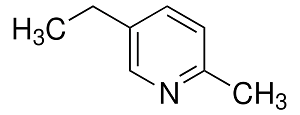2-Methyl-5-Ethyl Pyridine

Product Description
2-Methyl-5-ethylpyridine is a chemical compound with various industrial applications due to its unique properties.
Product:
2-Methyl-5-Ethyl Pyridine
CAS:
104-90-5
Synonym:
5-Ethyl-2-picoline; Aldehydine
Structure:

Typical Characteristics
Appearance
Colorless liquid
Boiling point
178 °C
Density
0.919 g/cm3
Flash Point
68 °C
Melting point
-70 °C
Molecular Weight
121.18
Odor
Strong aromatic odor
Purity
≥96%
Refractive index
1.497
Uses, Applications & Markets
Key applications
get a quote
We Offer 2-Methyl-5-Ethyl Pyridine
in various grades
A few of the grades available are listed below:



2-Methyl-5-Ethyl Pyridine used in many
industry applications
2-Methyl-5-ethylpyridine is a chemical compound with various industrial applications due to its unique properties. Here are some of its main uses:
- Flavor and Fragrance Industry: 2-Methyl-5-ethylpyridine is utilized as a key ingredient in the flavor and fragrance industry. It imparts a distinctive odor and flavor profile to consumer products such as food, beverages, and personal care items. Its aromatic properties make it valuable in the formulation of savory and meaty flavors, as well as in fragrances with woody and earthy notes.
- Chemical Synthesis: 2-Methyl-5-ethylpyridine serves as a versatile building block in organic synthesis, enabling the preparation of various functionalized derivatives with diverse chemical properties. It undergoes numerous chemical transformations, including alkylation, acylation, and oxidation, to produce intermediates and final products used in the synthesis of pharmaceuticals, agrochemicals, dyes, and specialty chemicals.
- Corrosion Inhibition: 2-Methyl-5-ethylpyridine is employed as a corrosion inhibitor in industrial applications where metal surfaces are exposed to corrosive environments. It forms a protective film on metal surfaces, inhibiting the electrochemical reactions that lead to corrosion and degradation. This property makes it valuable in the formulation of rust preventatives, metalworking fluids, and corrosion-resistant coatings.
- Pharmaceuticals: 2-Methyl-5-ethylpyridine and its derivatives have potential pharmaceutical applications due to their pharmacological properties. They are studied for their anti-inflammatory, analgesic, and anti-microbial activities, making them candidates for the development of new drugs to treat inflammatory diseases, pain disorders, and infectious conditions.
- Agrochemicals: 2-Methyl-5-ethylpyridine-based compounds have pesticidal properties and are used in the formulation of insecticides, fungicides, and herbicides for agricultural applications. They act as broad-spectrum pesticides, targeting various pests, pathogens, and weeds that threaten crop yields and plant health. 2-Methyl-5-ethylpyridine derivatives may be applied as foliar sprays, soil treatments, or seed treatments to protect crops from pests and diseases and enhance agricultural productivity.
- Photographic Chemicals: 2-Methyl-5-ethylpyridine has been used historically in the photographic industry as a sensitizer and stabilizer in black-and-white photographic emulsions. It enhances the sensitivity of photographic films and papers to light, allowing for the production of high-quality images with improved contrast and tonal range. 2-Methyl-5-ethylpyridine derivatives are also employed as dye-forming couplers and developers in color photography processes.
- Textile Industry: 2-Methyl-5-ethylpyridine derivatives find applications in the textile industry as colorants and dye intermediates. They are used to impart various shades of blue, green, and violet to textile fibers, yarns, and fabrics through dyeing and printing processes. 2-Methyl-5-ethylpyridine-based dyes exhibit good lightfastness, washfastness, and color retention properties, making them suitable for use in a wide range of textile applications, including apparel, home furnishings, and industrial textiles.
- Biotechnology: 2-Methyl-5-ethylpyridine compounds are valuable tools in biological research and biotechnology applications due to their interactions with biological molecules and cellular processes. They are utilized as fluorescent probes, enzyme inhibitors, and modulators of ion channels and neurotransmitter receptors in experimental systems. 2-Methyl-5-ethylpyridine derivatives have also been investigated for their potential therapeutic applications in cancer therapy, neurodegenerative diseases, and infectious diseases.
- Electrochemical Devices: 2-Methyl-5-ethylpyridine-based compounds are utilized in electrochemical devices and energy storage systems due to their redox activity and electrochemical stability. They serve as mediators and redox shuttles in rechargeable batteries, fuel cells, and electrochemical sensors, facilitating electron transfer reactions and improving device performance and cycle life.
- Adhesives and Sealants: 2-Methyl-5-ethylpyridine is sometimes used as an additive in adhesives and sealants formulations to improve adhesion, cohesion, and durability. It acts as a curing agent or cross-linking agent, promoting the polymerization or cross-linking of resin systems and enhancing the mechanical properties and chemical resistance of the final products.